If you believe traditional marketing is ineffective, you can’t be more wrong.
Check this out: A 30-second-long ad during the Super Bowl LVI telecast still costs marketers 6.5 million U.S. dollars on average in 2022.
No doubt, digital marketing is huge these days. With the inclusion of online marketing, the web has introduced new advanced technologies. This has totally altered the marketing mix.
Regardless, traditional marketing still has its relevance. In fact, many consumers still appreciate getting advertising mailers.
Bottom line? Consumer behavior has changed in a way that both offline and online marketing can coexist.
So what basically is traditional marketing, why is it still essential today, and what are the different offline marketing channels?
This article is your answer. It covers everything about traditional marketing, including what it is, its benefits, its different types, pros & cons, and also some tactics to start.
What is traditional marketing?
Traditional marketing, also known as conventional marketing, usually includes marketing collateral that is available offline.
This offline marketing mix consists of tactics, tools, and methods that do not use any online channels. So only offline channels are used to plan and carry out the strategy for the product, pricing, place, and promotion.

Image Source: Digital Marketing Group
Billboards, direct response mail, radio, and tv ads are some examples of traditional marketing.
Why is traditional marketing important?
In the era of online marketing, traditional marketing still holds value. In fact, a CMO survey of marketers estimated that conventional ad spending will rise by 1.4% and 2.9% in August 2021 and February 2022.
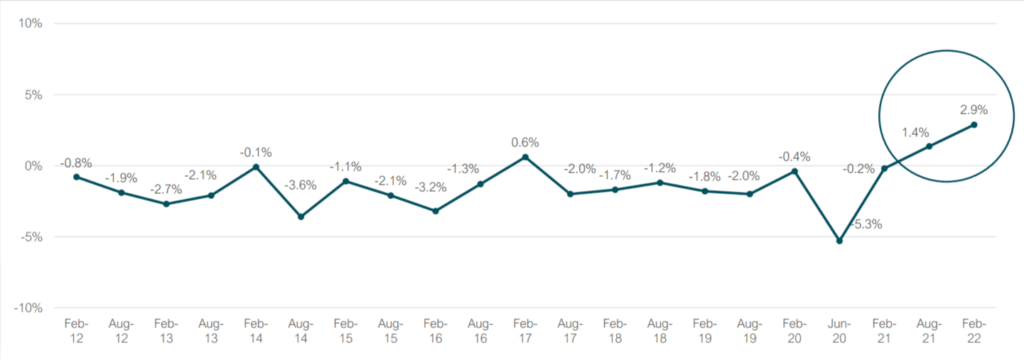
Image Source: The CMO Survey
This proves that conventional marketing is not dead even when digitalization continues.
For in-person, expert, and interactive marketing, offline marketing methods are still a precious trump card. Take cold calling, for example. It is a favored method to attract clients and earnings even today.
Traditional marketing is essential because it reaches prospects who don’t use phones and desktops as much. When ads are placed in areas that many people frequent, they attract a larger target group.
For example, installing billboards or bus ads all over a neighborhood helps bring more leads and increases brand recognition. If targeting local people is among your company’s objectives, offline marketing channels such as newspaper advertising, TV & radio ads, or print item help you reach the local target group and build brand awareness among residents.
Features/benefits of traditional marketing
Traditional marketing has a lot of benefits. Let’s see what they are:
More trustworthy
In a YouGov survey, nearly 50% of US citizens voted advertising on print (46%), radio (45%), and TV (46%) as credible.

Image Source: MarketingCharts
Needless to say, traditional marketing inspires more trust than digital marketing. For example, ads on bigger mediums and print ads are often considered more credible.
This happens because offline marketing is linked with big budgets. Any organization that goes for radio or TV ads has to be financially capable. So the firm displays a reputation for prosperity and consistency.
Captures a large, diverse audience
Leading offline channels like print, radio, and television beat online marketing mediums, as found in an Ebiquity study. They get more attention, engagement, and reach, assuming the same spending in both cases.
A company can connect to wide and varied types of audiences with the help of offline marketing. For instance, radio, billboards, and TV ads spread your word to different locations and get you in front of your target market.
Enormous brand exposure
Print marketing collateral – a traditional marketing medium – is easier to handle and has a better brand recall. And the company gets fantastic exposure when these commercials are seen by a wide audience.
Disadvantages of traditional marketing
To predict and manage any problems that you might face, you must be familiar with the disadvantages of conventional marketing. Here are the main drawbacks:
Hard to segment target market
Offline marketing spreads the word to a large group of people. But here’s the bummer: It doesn’t allow for the same level of audience targeting and segmentation as digital marketing.
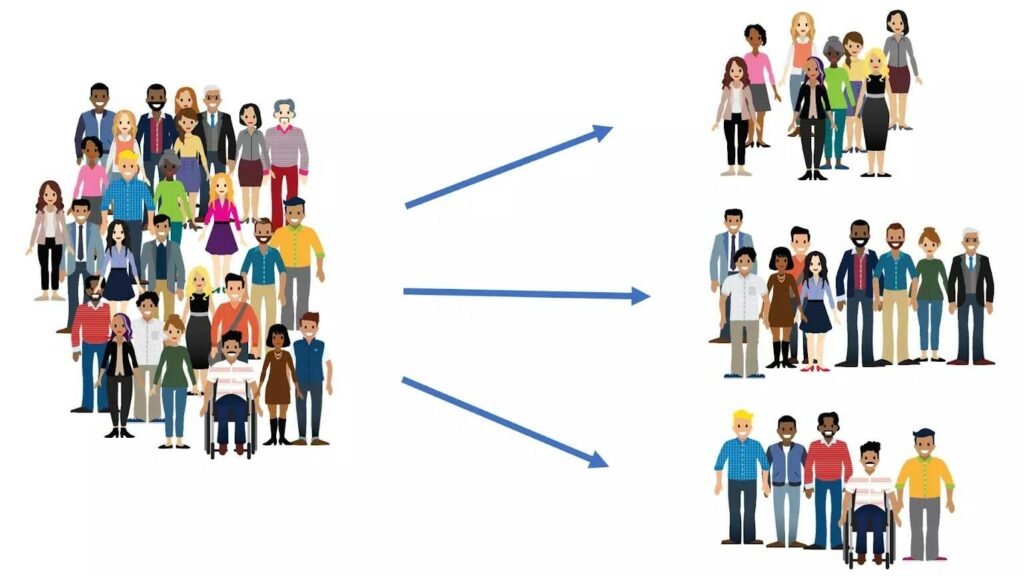
Image Source: Trailhead
For example, traditional marketing methods cannot segregate the target group in terms of gender, earnings, habits, age, etc.
Very costly
Whenever brands prepare to launch an offline marketing campaign, they must spend money to give out brochures or leaflets or to place newspaper ads. Along with the price of buying TV ad spots, they might need to pay for creating those ads too.

Image Source: Jootoor Designs
And that’s not all. To get the most out of broadcast ads, businesses will likely have to buy a lot of ad placements. Bottom line? They might need to invest a hefty amount before getting any payback.
Hard to measure impact
Offline marketing is often less measurable than online marketing. Although there are solutions that can assess billboard drive-bys and television viewership, they are estimates at best.
With digital media, on the other hand, you can detect KPIs like sales, page traffic, and click-through at every stage of the sales funnel.
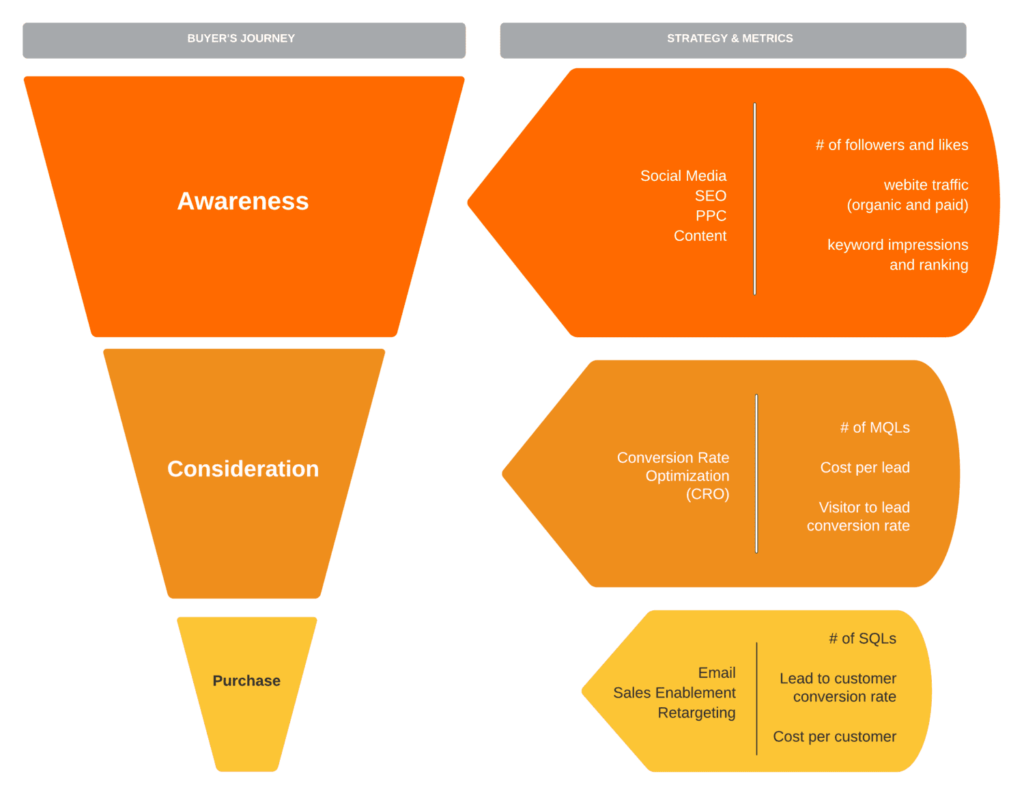
Image Source: Knomad Digital Marketing
Less flexibility
Conventional marketing doesn’t give brands the opportunity to make changes based on the response of the audience.
For example, if a business wants to place an ad in a newspaper, the ad must be fully ready before that. Once the advertisement is published or created, then it can’t be changed without incurring significant costs. And this applies to all traditional marketing.
Traditional marketing vs digital marketing
The world is evolving into a digital realm. Most of the buyers’ everyday tasks like banking and newspaper reading have moved online.
However, conventional marketing still interests people. Marketing efforts won’t be as successful without offline marketing.
Each type of marketing has advantages and disadvantages. Let’s see how offline marketing differs from online marketing.
Most conventional marketing methods are incapable of offering the same degree of audience targeting and segmentation as online marketing.
With the help of technological developments, websites can collect their visitor’s individual data, which helps online marketers target prospects more accurately. So with online marketing, marketers can place adverts before a particular segment.
Digital marketing provides brands an opportunity to adjust their ads according to the response of the audience. Online ads can be adjusted and assessed in real-time to maximize their effectiveness. But all of this is not possible in the case of offline marketing.
Mostly traditional marketing is not as measurable as digital marketing. There are solutions to assess billboard drive-bys and television viewership, but they are just estimates. While on the contrary, online media may determine KPIs like click-throughs, sales, and web traffic throughout the sales funnel.
Conventional marketing yields businesses more trust than digital marketing. One explanation behind this is that offline marketing is tied to bigger budgets. A company must be financially capable to pay for TV or radio ads. Therefore, the firm is perceived as stable and growing.
Traditional marketing channels/methods
Conventional marketing can be seen all around us. For example, a big billboard on a crowded road, a sales agent going to customers’ doorsteps, etc. are few examples of traditional marketing.
There are different types of traditional marketing channels, you can choose from. Some of the commonly used methods are explained below.
Outdoor advertising
Outdoor advertising, also known as out-of-home marketing, is a technique used to connect with the audience or clients in any place that is not their home or office. It is represented via graphic advertising media.
Usually, this channel depends more on pictures rather than words to convey a message to the target group.
For example, billboards are one of the mediums of OOH marketing. They are usually found on expressways. Along with brand images, they show ads. Billboards include graphics with supporting text that delivers a short but unforgettable message to the people that drive by.
Thanks to innovative billboard ads, your audience can easily identify and remember your business. If you plan to get national or local brand recognition, billboards can connect you with a large audience from different locations.
In fact, 56% of US adults consider billboard advertising as helpful when deciding to make a purchase.
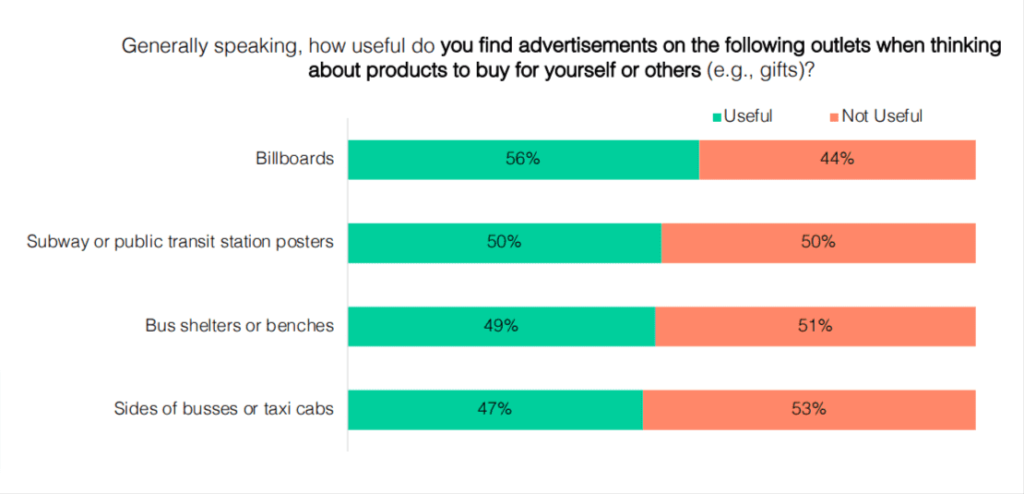
Image Source: OAAA
This advertising strategy includes places like shopping malls, movie theaters, and stadiums along with signage, billboards, and street furniture including bus stops and benches.
Think of the places your target group hangs out the most before beginning out-of-home marketing. Are they traveling in public transport, shopping in a mall, or driving on a highway?
For instance, if you are advertising a clothing outlet, investing in an advertisement spot in the neighborhood (such as a mall) will encourage customers to visit your shop.
Once you discover a decent spot, look around you to check billboards, signs, and other ad platforms. Do you see any empty medium? If yes, there will be contact details of the individual who takes care of those platforms. Contact them.
Broadcasting
The process of distributing content or programs via platforms like TV and radio is known as broadcasting.
Approximately 156 million grown-ups in the US – 63% of US citizens – listen to the radio every day. According to the same study, radio has also got the highest proportion of the listening time.

Image Source: Radio Ink
Broadcast advertising tactics such as radio and TV advertising can be used to reach out to a large number of people rapidly. Which, as a result, enhances brand awareness.
To get started, identify the most loved radio and television channels and shows among your target group. Then, check their contact details on the web and connect with them to talk about your marketing campaign.
Print marketing
At a CAGR of 3.5%, the value of the worldwide print media market is anticipated to increase from $305.44 billion in 2021 to $366.73 billion in 2026.
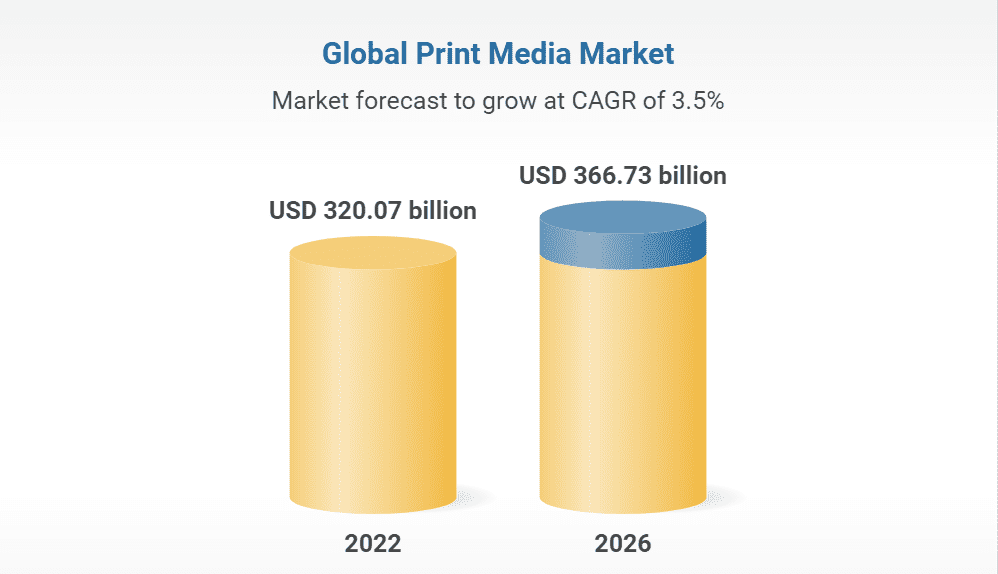
Image Source: GlobeNewswire
Print marketing involves promoting services and goods via magazines, newspapers, and other print media like journals and books.
You may attract more potential buyers with print ads by using channels like magazines or newspapers.
For example, there are magazines that only cater to a specific group like women or fashion. You can use them to target a particular audience.
To begin, find out the kinds of magazines or other print mediums that your prospects are interested in. Then, get your ads published in selected magazines or mediums to boost your sales.
Handout, also a print marketing medium, is a printed paper, such as a flyer or brochure, that advertises a sale, company, or occasion. You can use a flyer or handout to create awareness for any company event by putting these flyers in public places for your prospects to see.
Next on the list are Brochures. It includes information like features of a software/product or details about an organization, that you can give your potential customers or hand out in any event. People can either keep it with them or save it for the future when they wish to know about your firm or product.
Direct mail
According to a Lob survey, 64% of marketers think direct mail has the most response rate among marketing channels they use. The same survey revealed that 60% of marketers said direct mail has the greatest ROI of all mediums used by them.
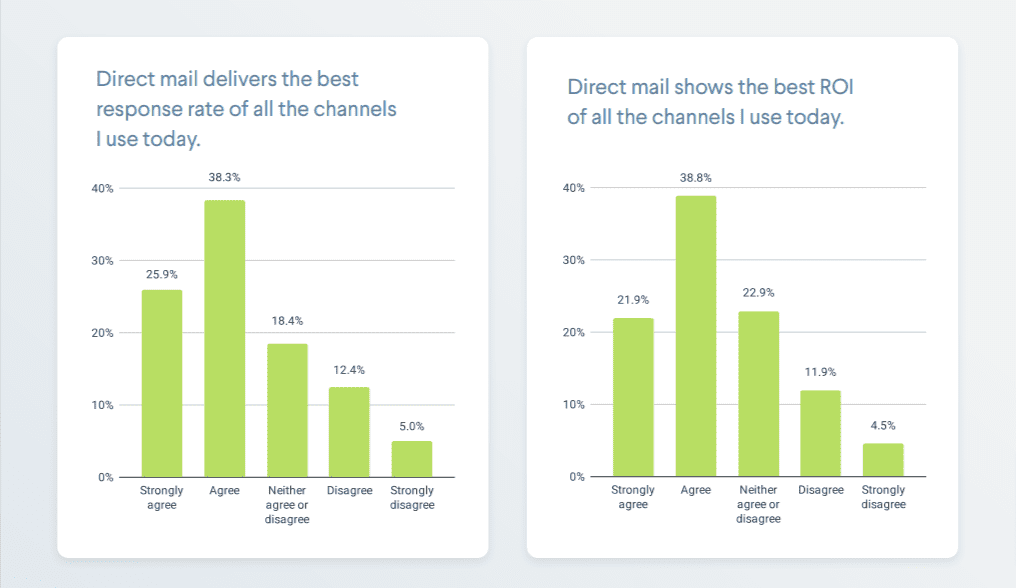
Image Source: Lob
Direct mail is the marketing material that is mailed to prospective customers.
Direct mail marketing involves sending print collateral such as letters, postcards, etc., to the homes of your target group in your target location.
Flyers, postcards, letters, catalogs, brochures, and other print material are among the various kinds of direct mail marketing strategies. They are sent straight to potential customers to raise product awareness.
To publish, stamp, and ship your postcards, brochures, or flyers, you may go for direct mail companies such as NextDayFlyers and Vistaprint. Some of these companies also go above and beyond by offering design templates and assisting you in compiling a list of feasible locations.
Telemarketing/Cold calling
82% of customers agree to meet with a salesperson who reaches out in an assertive manner. And cold calling is one such method.

Image Source: RAIN Group
Telemarketing is a method where companies employ salespeople to make marketing calls or purposes. It is also known as cold calling. A cold call includes contacting, notifying, and convincing prospective buyers over a phone call.
You can contact your prospective consumer personally with the help of a cold-calling strategy. Also, tell them everything about the product you are offering and how it can fix any issues they or their firms are facing.
This will help enable a better personal relationship and trust between you and your prospects.
How to start traditional marketing
When planning a traditional marketing campaign, due diligence is essential. Here are the steps to start traditional marketing.
Set your budget
You must specify your spending limits at the beginning of a promotional campaign. It can allow you to figure out the marketing methods you can choose. Say an advertisement on a major television network is out of your reach, then you can go for a direct mail campaign.
While preparing your marketing budget, outline all your possible expenses to ensure that you don’t go over your budget limit. There are many calculations involved. So you must use a marketing budget template.
ProjectManager offers a free marketing budget template for Excel, designed to assist you in starting a campaign and keep your budget in check.
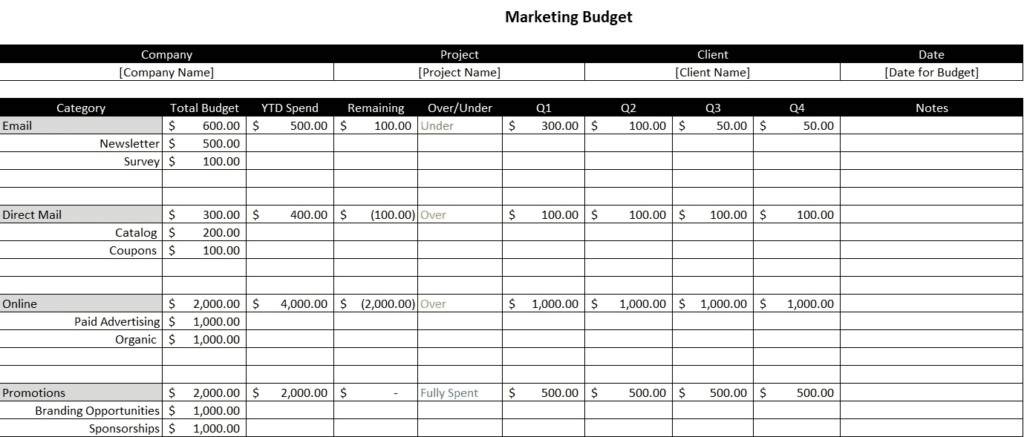
Ensure consistent message
According to a Lucidpress survey, brand consistency has been estimated to boost income by 33%.
Brand consistency is essential in a promotional project. The language, visuals, color, and tonality you use convince the consumer in a similar way. This leads to better brand recall.
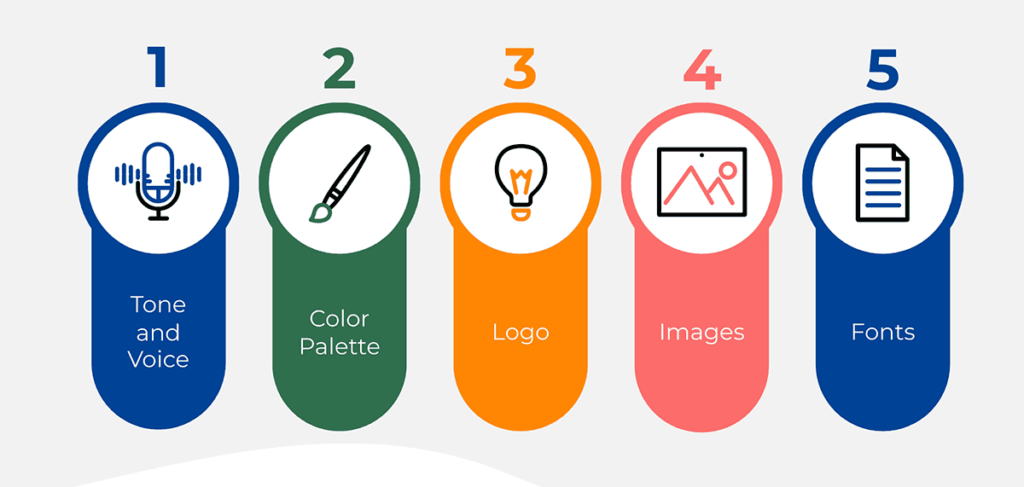
Image Source: Visme
A great way to do this is to prepare a campaign-style guide. It ensures that the message and goals of each ad in the campaign are true to the brand and consistent.
Determine potential partners
If you are considering promoting your brand on radio, newspaper, television, or magazine, you’ll have to determine the publications or networks you could partner with.
This partner company cannot be a direct rival. However, it must support your brand and serve the same target group or have the same marketing purpose as yours.
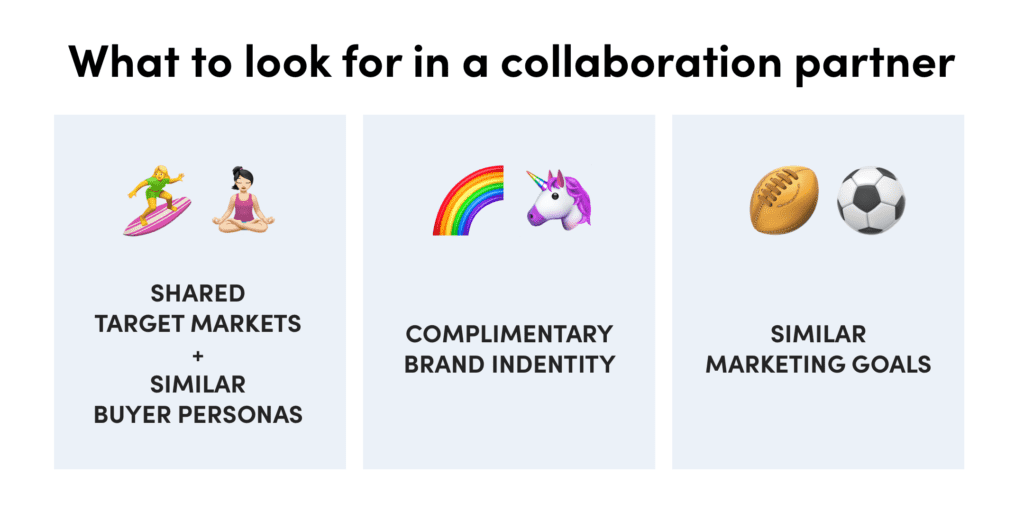
Image Source: Ampjar
Once you have selected a few brands, contact these firms to ask about buying an advertisement spot. Also, be ready to explain to them how learning about your goods or services will help their viewers or readers.
Employ more staff
A few offline marketing campaigns might need professionals such as filmmakers, content writers, graphic designers, etc.
Below is an example of a firm’s marketing team structure.

Image Source: Wrike
If you do not have these experts on your marketing team, you can always hire an agency service or a few freelancers to achieve your marketing objectives on a budget and on schedule.
Conclusion
Traditional marketing is crucial for the marketing mix even today. For example, many people believe that printed content is the most trustworthy. They would rather read a newspaper than a desktop screen, as they like the texture of print media.
The core component of an effective marketing plan is finding the right combination between online and offline channels. Both are essential elements of a marketing strategy, but they work best when combined.
Did we miss anything? Did you try these channels? Do you have any questions or comments? Share your thoughts below in the comments section.

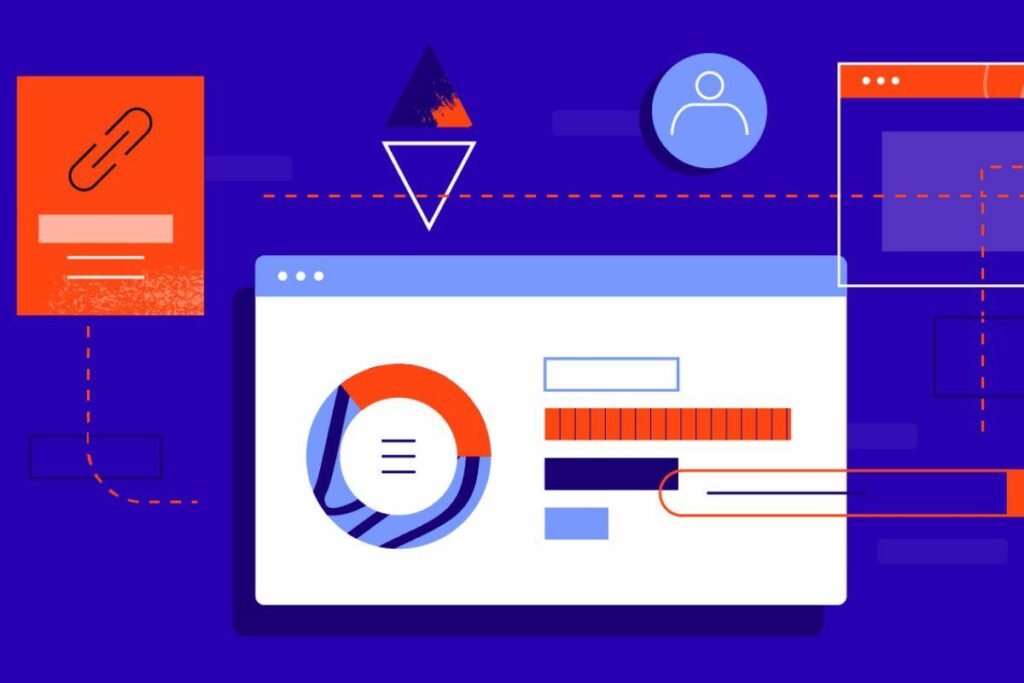

your blog gives very good difference regarding traditional marketing and digital marketing.
thank you